Long-Term Evolution of Ecologically Fragile Waterside Rural Areas and Strategies for Local Spatial Planning: An Empirical Study in Baiyangdian, China
Abstract
1. Introduction
2. Theoretical Foundations and State of the Art
2.1. Chinese Rural Policies under Urbanization and Counterurbanization
2.2. Spatio-Temporal Evolution and Driving Mechanism of China’s Rural Settlements
- A single factor can have positive impacts in some locations while exerting negative effects in others. For example, small water bodies may serve as productive elements in certain areas, attracting settlements, whereas large water bodies pose flood risks, leading to settlement aversion in other regions [48];
- The significance of a factor’s impact is subject to scale effects. Natural elements generally have significant influences across all scales, economic factors tend to be more influential at intermediate scales, and social factors, such as policies, primarily affect the smallest scales [46];
2.3. Spatial Consolidation and Reconstruction Strategy for Spatial Planning
2.4. Summary
3. Study Area, Materials, and Methodology
3.1. Study Area
- Land settlements, which are completely located on dry land;
- Semi-waterside settlements, which are situated alongside embankments or incorporate into the village layout;
- Water settlements, which are constructed within the water body itself.
3.2. Materials
3.3. Methodology
3.3.1. Measurement of Settlement Evolution
- (1)
- Area evolution
- (2)
- Rank sum test
- (3)
- Spatial autocorrelation
- > 1.96: the probability of a random high-cluster is less than 5%;
- −1.96 < < 1.96: random distribution;
- < −1.96: the probability of a random low-cluster is less than 5%.
3.3.2. Driving Mechanism
- (1)
- Indicator system
- (2)
- Geographically weighted regression (GWR)
- (3)
- Geographically and temporally weighted regression (GTWR)
3.3.3. Destination Search
- (1)
- Two-step floating catchment area
- (2)
- Migration–recipient settlement matching
4. Results
4.1. Evolution of Settlements
- Settlements in close proximity tend to expand and merge due to mutual gravitational forces, such as the villages between Santai Town and Anxin County Town, and the villages in Laohetou Town;
- Some settlements exhibit a linear expansion trend due to the attraction of road elements, for example, those along the Baoxin Highway; the semi-waterside settlements adjacent to dikes show a tendency to initially expand towards water bodies before extending into the plains, as seen in Duancun Town, indicating the dual influence of water bodies on human settlements;
- Furthermore, the larger settlements demonstrate a greater potential for expansion, leading to a tendency for larger-scale expansion.
4.2. The Difference in Evolution Paths among Three Types of Settlements
4.3. Evolution-Driving Mechanism
- The significant influence factors in 1936 include FloR and Pop. FloR exhibits strong positive effects in the northern and southwestern areas of water bodies, while Pop mainly influenced southwest plain were less affected by water;
- In 1964, WSA exhibited a negative impact, particularly affecting villages in Liulizhuang Town. The impact of FloR was similar to that in 1936. TransAcc displayed a negative effect in the Liulizhuang Town area and in several semi-waterside settlements. The positive effect of LI was significant primarily situated on the west side of water bodies, including Zhaili Town, Laohetou Town, and Anzhou Town (the former county center), showing the highest impact intensity. The influence patterns of the POP and REV are similar to those in 1936, with a notable positive impact in areas with minimal influence from water bodies;
- In 1975, WSA exhibited a notably negative effect on villages in the southwest plain that far from the water bodies. CroQ had a significant positive impact on many water settlements and those on the northern shore of the Baiyangdian Lake. REV kept the influence pattern in 1964. Additionally, in comparison to previous results, the influence of the Pop factor expanded to include Liulizhuang Town on the southern side of the water bodies;
- In 1996, FloR and TransAcc both affect the southwest region of the county, with the former exhibiting a positive impact and the latter a negative impact. The positive impact range of LI encompasses most settlements except those in the southwestern plains. The influence range of Pop expands towards the north shore, while the influence range of REV remains unchanged;
- In 2008, the positive impact range of CroQ was only significant in the northern areas of Dawang Town and Anxin Town, no longer showing a significant impact on water settlements. The influence range of REV expands towards the north shore. BdEx had a negative impact on expansion, only concentrating in the southern part of Liulizhuang Town.
- EcoS exhibited a weak negative effect up to 1975; a strong positive effect emerged in 1975, but it changed to a strong negative effect in 1996, followed by a strong positive effect in 2008, indicating the recent expansion of eco-sensitive villages without considering environmental damage;
- WSA showed a strengthened negative effect from 1936 to 1975, but it changed to a positive effect after 1996. It also indicates that settlements closely integrated with water bodies experienced faster expansion, leading to disturbances in the ecosystem in recent years;
- FloR consistently demonstrated a weak negative impact on expansion;
- TP also showed a shift in direction, from a positive effect from 1936 to 1975 to a negative effect from 1996 to 2008, reflecting a preference for expansion first in semi-waterside and water settlements and later in semi-waterside and land settlements;
- TransAcc firstly displayed a weak positive impact in 1936, which turned into a negative impact in 1964 and 1975, which intensified in 1996 and 2008, mainly affecting plains settlements far from water bodies. Their growth was inhibited due to the concentration of village points in this area;
- LI exhibited a negative impact until 1996, especially in 1964. In earlier years, the higher-level administrative center, while providing market services to the lower-level center, also had a restraining effect on the lower-level market. With the weakening of the restraining effect due to the rural construction movement during the reform and opening up, it turned into a driving force, and after 1996, the impact of the location factor was entirely positive; its impact peaked in 2008.
- The Pop coefficient was consistently positive, and its positive effect gradually strengthened from 1936 to 1996 but diminished after 2008. Village-area expansion is no longer largely driven by simple population growth, and expansion is not necessarily used to construct more housing, potentially due to the development of other enterprises or factories.
- With the exception of 1936 and 1975, REV consistently had a strong positive impact on expansion.
- BdEx exhibited a positive effect before 1996, which turned into a negative effect in 1996 and intensified. Well-developed internal villages previously tended to expand outward, but after 1996, they could no longer balance internal development and expansion.
4.4. Optimizing Strategy for Land Consolidation
5. Discussion
- Emphasize the development of waterfront areas as a place integrating folk culture and resilient waterside landscapes. Use historical-scenario narratives to showcase traditional scenes, such as fishing and reed production. Furthermore, to minimize ecological disruption and meet the needs of seasonal agricultural production activities, it is advisable to design a spatial utilization plan that allows for flexible use based on seasonal production activities.
- Considering the current contradiction between external village expansion and internal construction, it is important to focus on the efficient use of existing land resources. Each settlement needs to prioritize infilling at the boundaries instead of further land occupation. In densely populated areas, such as the settlements in the southwest vicinity adjacent to major transportation arteries with relatively uniform development levels, promote the consolidation process to achieve the aggregation of residential land and enhance land utilization efficiency.
- In terms of transportation accessibility, planning for the future ”fast and efficient transportation network” requires the establishment of a rational road network connecting settlement points, forming a multi-level road network structure that is well organized and appropriately dense. In the current road network system, certain roads, such as Rongli Highway, need additional intersections with other main roads to effectively connect clusters of villages and improve the overall efficiency of the network.
6. Conclusions
Author Contributions
Funding
Data Availability Statement
Conflicts of Interest
References
- Chen, G.; Noszczyk, T.; Nawieśniak-Caesar, M.; Pazdan, M.; Hernik, J. Land use change and landscapes in rural areas in china in forty years of reform and opening up. In Cultural Heritage—Possibilities for Land-Centered Societal Development; Springer: Cham, Switzerland, 2022; pp. 345–356. [Google Scholar]
- Huang, J. China’s rural transformation and policies: Past experience and future directions. Engineering 2022, 18, 21–26. [Google Scholar] [CrossRef]
- Li, Y.; Jia, L.; Wu, W.; Yan, J.; Liu, Y. Urbanization for rural sustainability–Rethinking China’s urbanization strategy. J. Clean. Prod. 2018, 178, 580–586. [Google Scholar] [CrossRef]
- Zhang, L. Conceptualizing China’s urbanization under reforms. Habitat Int. 2008, 32, 452–470. [Google Scholar] [CrossRef]
- Wang, L. China’s new town movements since 1949: A state/space perspective. Prog. Plan. 2022, 155, 100514. [Google Scholar] [CrossRef]
- Long, H.; Li, Y.; Liu, Y.; Woods, M.; Zou, J. Accelerated restructuring in rural China fueled by ‘increasing vs. decreasing balance’land-use policy for dealing with hollowed villages. Land Use Policy 2012, 29, 11–22. [Google Scholar] [CrossRef]
- Tao, A. Spatial differentiation pattern and comprehensive regionalization of rural settlement characteristics in China. Acta Geogr. Sin. 2023, 78, 3144–3160. [Google Scholar]
- Pang, F.; Peng, X. Analysis on the Historical and Realistic Value of Villages in Baiyangdian Water Area. J. Hebei Open Univ. 2021, 26, 96–99. [Google Scholar]
- Xia, S. Anxin County Annals: 1978–2008; China Local Records Publishing House: Beijing, China, 2017. [Google Scholar]
- Huibo, W. Hebei Xiong’an New Area Planning Outline. Available online: http://www.xiongan.gov.cn/2018-04/21/c_129855813.htm (accessed on 3 August 2024).
- Huibo, W. Notice of the People’s Government of Hebei Province on Printing and Distributing the “14th Five-Year Plan” for Ecological and Environmental Protection in Hebei Province. Available online: http://www.xiongan.gov.cn/2022-02/16/c_1211574089.htm (accessed on 3 August 2024).
- Yang, J. On the nature of counterurbanization. In Human Geography; Routledge: London, UK, 1995; p. 6. [Google Scholar]
- Dilley, L.; Gkartzios, M.; Odagiri, T. Developing counterurbanisation: Making sense of rural mobility and governance in Japan. Habitat Int. 2022, 125, 102595. [Google Scholar] [CrossRef]
- Berry, B.J. Urbanization and counterurbanization in the United States. Ann. Am. Acad. Political Soc. Sci. 1980, 451, 13–20. [Google Scholar] [CrossRef]
- Mitchell, C.J. Making sense of counterurbanization. J. Rural. Stud. 2004, 20, 15–34. [Google Scholar] [CrossRef]
- Sexto, F.C. Is the counterurbanization process a chaotic concept in academic literature? Geogr. Pannonica 2009, 13, 53–65. [Google Scholar] [CrossRef]
- Cloke, P. Counterurbanisation: A rural perspective. Geography 1985, 70, 13–23. [Google Scholar] [CrossRef]
- Lewis, G.; McDermott, P.; Sherwood, K. The counter-urbanization process: Demographic restructuring and policy response in rural England. Sociol. Rural. 1991, 31, 309–320. [Google Scholar] [CrossRef]
- Herrero-Jáuregui, C.; Concepción, E. Effects of counter-urbanization on Mediterranean rural landscapes. Landsc. Ecol. 2023, 38, 3695–3711. [Google Scholar] [CrossRef]
- Bartosiewicz, B.; Cusack, C. Countering Counter-Urbanization: A Comparative Analysis of Resiliency and Redevelopment in Postindustrial Cities of the United States and Poland. In Urban Dynamics, Environment and Health: An International Perspective; Springer: Berlin/Heidelberg, Germany, 2024; pp. 625–642. [Google Scholar]
- Corey, K.E. Development in Sri Lanka: A model for counterurbanization policies and planning? Urban Geogr. 1987, 8, 520–539. [Google Scholar] [CrossRef]
- Zheng, N.; Wang, S.; Wang, H.; Ye, S. Rural settlement of urban dwellers in China: Community integration and spatial restructuring. Humanit. Soc. Sci. Commun. 2024, 11, 1–12. [Google Scholar] [CrossRef]
- Hu, Y.; Wang, Y.; Zhang, P. Anti-urbanization and rural development: Evidence from return migrants in China. J. Rural Stud. 2023, 103, 103102. [Google Scholar] [CrossRef]
- Cheng, M.; Yin, Z.; Westlund, H. Counterurbanization in China? A case study of counties in Huang-Huai-Hai area from the perspective of urban-rural relations. J. Rural Stud. 2024, 110, 103386. [Google Scholar] [CrossRef]
- Chen, B. Development Opportunities for Chinese Villages and Towns in the Context of “Counterurbanization”—A Discussion on Sustainable Urbanization. Soc. Sci. Res. 2007, 3, 53–57. [Google Scholar]
- Liu, P.; Bai, X.; Ravenscroft, N. Counterurbanization, gentrification and the potential for rural revitalisation in China. Popul. Space Place 2023, 29, e2680. [Google Scholar] [CrossRef]
- Ruijun, D. The Experience of Urbanization in Developed Western Countries and Its Implications for China. City 2008, 10, 54–57. [Google Scholar]
- Jian, L.; Gaofeng, X. A policy discourse on new town development in contemporary china. City Chin. New Towns 2019, 59–70. [Google Scholar] [CrossRef]
- Han, L.; Lu, M.; Xiang, K.; Zhong, H. Density, distance and debt: New-town construction and local-government financial risks in China. J. Asian Econ. 2021, 77, 101376. [Google Scholar] [CrossRef]
- Zhou, Y.; Li, X.; Liu, Y. Land use change and driving factors in rural China during the period 1995–2015. Land Use Policy 2020, 99, 105048. [Google Scholar] [CrossRef]
- Li, Y.; Chen, C.; Wang, Y.; Liu, Y. Urban-rural transformation and farmland conversion in China: The application of the environmental Kuznets Curve. J. Rural Stud. 2014, 36, 311–317. [Google Scholar] [CrossRef]
- Li, Y.; Long, H.; Liu, Y. Spatio-Temporal Pattern of China’s Rural Development: A Rurality Index Perspective. J. Rural Stud. 2015, 38, 12–26. [Google Scholar] [CrossRef]
- Long, H.; Zou, J.; Pykett, J.; Li, Y. Analysis of rural transformation development in China since the turn of the new millennium. Appl. Geogr. 2011, 31, 1094–1105. [Google Scholar] [CrossRef]
- Liu, Y.; Lu, S.; Chen, Y. Spatio-temporal change of urban–rural equalized development patterns in China and its driving factors. J. Rural Stud. 2013, 32, 320–330. [Google Scholar] [CrossRef]
- Liu, Y.; Zhou, Y.; Liu, J. Regional Differentiation Characteristics of Rural Poverty and Targeted Poverty Alleviation Strategy in China. Bull. Chin. Acad. Sci. 2016, 31, 269–278. [Google Scholar]
- Long, H.; Li, Y.; Liu, Y. Analysis of evolutive characteristics and their driving mechanism of hollowing villages in China. Acta Geogr. Sin. 2009, 64, 1203–1213. [Google Scholar]
- Chen, Y.; Sun, H.; Liu, Y. Reconstruction models of hollowed villages in key agricultural regions of China. Acta Geogr. Sin. 2010, 65, 727–735. [Google Scholar]
- Zhou, Y.; Huang, H.; Liu, Y. The spatial distribution characteristics and influencing factors of Chinese villages. J. Geogr. Sci. 2020, 75, 2206–2223. [Google Scholar]
- Yang, R.; Liu, Y.; Long, H.; Qiao, L. Spatio-Temporal Characteristics of Rural Settlements and Land Use in the Bohai Rim of China. J. Geogr. Sci. 2015, 25, 559–572. [Google Scholar] [CrossRef]
- Zhu, F.; Zhang, F.; Li, C.; Zhu, T. Functional Transition of the Rural Settlement: Analysis of Land-Use Differentiation in a Transect of Beijing, China. Habitat Int. 2014, 41, 262–271. [Google Scholar] [CrossRef]
- Long, H.; Liu, Y.; Wu, X.; Dong, G. Spatio-Temporal Dynamic Patterns of Farmland and Rural Settlements in Su–Xi–Chang Region: Implications for Building a New Countryside in Coastal China. Land Use Policy 2009, 26, 322–333. [Google Scholar] [CrossRef]
- Yang, R. An analysis of rural settlement patterns and their effect mechanisms based on road traffic accessibility of Guangdong. Acta Geogr. Sin. 2017, 72, 1859–1871. [Google Scholar]
- Wang, C.; Sun, G.; Zhu, S. The major research progress on spatial evolution of rural settlements in mountainous areas of western China. Hum. Geogr. 2011, 26, 9–14. [Google Scholar] [CrossRef]
- Liu, Z.; Ding, Y.; Jiao, Y.; Wang, J.; Liu, C.; Yang, Y.; Wei, J. Spatial patterns and controlling factors of settlements distribution in ethic minority settlements of southwest China: A case study of Hani terraced fields. Prog. Geogr. 2021, 40, 257–271. [Google Scholar] [CrossRef]
- Hai, B.; Li, X.; Xu, J. Spatio-temporal evolution of rural settlements in Gongyi. Geogr. Res. 2013, 32, 2257–2269. [Google Scholar]
- Yanbo, Q.; Guanghui, J.; Yuting, Y.; Qiuyue, Z.; Yuling, L.; Wenqiu, M. Multi-Scale Analysis on Spatial Morphology Differentiation and Formation Mechanism of Rural Residential Land: A Case Study in Shandong Province, China. Habitat Int. 2018, 71, 135–146. [Google Scholar] [CrossRef]
- Zhu, B.; Ma, X. A Research on Pattern Characteristics and Type Classification of Rural Settlement in Northern Jianggsu Province. Hum. Geogr. 2011, 26, 66–72. [Google Scholar] [CrossRef]
- Li, X.; Li, H.; Zhang, Y.; Yang, L. Spatial Patterns and the Regional Differences of Rural Settlements in Jilin Province, China. Sustainability 2017, 9, 2170. [Google Scholar] [CrossRef]
- Guo, X.; Zhang, Q.; Ma, L. Analysis of the Spatial Distribution Character and its Influence Factors of Rural Settlement in Transition-region between Mountain and Hilly. Econ. Geogr. 2012, 32, 114–120. [Google Scholar] [CrossRef]
- Xu, Z.; Zhao, C. Temporal and Spatial Pattern Evolution of Rural Settlements in the Karst Trough Valley Area in the Past 50 Years. Int. Soil Water Conserv. Res. 2020, 27, 8. [Google Scholar]
- Yang, X.; Song, K.; Pu, F. Laws and trends of the evolution of traditional villages in plane pattern. Sustainability 2020, 12, 3005. [Google Scholar] [CrossRef]
- Zhang, Z. Sudy on the Spatial Pattern of Settlements in Ningling County; Henan University: Kaifeng, China, 2019. [Google Scholar]
- Yang, R.; Liu, Y.; Long, H.; Wang, Y.; Zhang, Z. Spatial Distribution Characteristics and Optimized Reconstructing Analysis of Rural Settlement in China. Sci. Geogr. Sin. 2016, 36, 170–179. [Google Scholar] [CrossRef]
- Zhou, L.; Zhen, F.; Wang, Y.; Xiong, L. Modeling the spatial formation mechanism of poverty-stricken counties in China by using geographical detector. Sustainability 2019, 11, 4752. [Google Scholar] [CrossRef]
- Shcherbina, E.; Gorbenkova, E. Factors influencing the rural settlement development. Ifac-Papersonline 2019, 52, 231–235. [Google Scholar] [CrossRef]
- Tong, D.; Sun, Y.; Tang, J.; Luo, Z.; Lu, J.; Liu, X. Modeling the interaction of internal and external systems of rural settlements: The case of Guangdong, China. Land Use Policy 2023, 132, 106830. [Google Scholar] [CrossRef]
- Xue, M.Y.; Wang, C.X.; Dou, W.S.; Wang, Z. Spatial distribution characteristics of traditional villages in the Yellow River basin and influencing factors. J. Arid. Land Resour. Environ. 2020, 34, 94–99. [Google Scholar]
- Li, H.B.; Zhang, X.L.; Wu, Q.Y.; Wang, Y.H. Characteristics and Mechanism of Rural Settlements Spatial Reconstruction in Developed Areas——A Case Study of Southern Jiangsu. J. Nat. Resour. 2015, 30, 591–603. [Google Scholar]
- Li, Z.; Zhang, X.; Li, H. Evolution characteristics and driving mechanism of urban-rural scale system at county level:A case of Zhangjiagang city, Jiangsu province. J. Nat. Resour. 2019, 34, 140–152. [Google Scholar]
- Li, X. Spatial Evolution of Rural Settlements in Underdeveloped Areas; Science Press: Beijing, China, 2019. [Google Scholar]
- Yu, G.; Feng, J.; Che, Y.; Lin, X.; Hu, L.; Yang, S. The identification and assessment of ecological risks for land consolidation based on the anticipation of ecosystem stabilization: A case study in Hubei Province, China. Land Use Policy 2010, 27, 293–303. [Google Scholar] [CrossRef]
- Pašakarnis, G.; Maliene, V. Towards sustainable rural development in Central and Eastern Europe: Applying land consolidation. Land Use policy 2010, 27, 545–549. [Google Scholar] [CrossRef]
- Zhou, Y.; Guo, L.; Liu, Y. Land consolidation boosting poverty alleviation in China: Theory and practice. Land Use policy 2019, 82, 339–348. [Google Scholar] [CrossRef]
- Zhou, Y.; Li, Y.; Xu, C. Land consolidation and rural revitalization in China: Mechanisms and paths. Land Use Policy 2020, 91, 104379. [Google Scholar] [CrossRef]
- Long, H.; Zhang, Y.; Tu, S. Rural vitalization in China: A perspective of land consolidation. J. Geogr. Sci. 2019, 29, 517–530. [Google Scholar] [CrossRef]
- Li, J.; Lo, K.; Zhang, P.; Guo, M. Reclaiming small to fill large: A novel approach to rural residential land consolidation in China. Land Use Policy 2021, 109, 105706. [Google Scholar] [CrossRef]
- Guan, X.; Zhang, F.R.; Liu, C.; Li, L.; Zhao, H. Spatio-Temporal Analysis and Optimization of Rural Residential Land Distribution in Pinggu District. Resouces Sci. 2013, 35, 536–544. [Google Scholar]
- Chen, Y.; Xie, B. The spatial evolution and restructuring of rural settlements in Jiangnan hilly region: A case study in South Jiangxi. Geogr. Res. 2016, 35, 184–194. [Google Scholar]
- Li, J.; Wu, Y.D.; Zhang, L.; Chen, C.Y. The Suitability Evaluation of Social and Economic Factors on the Location of Rural Settlement—Take Erhai Rim Region of Yunnan for Example. Econ. Geogr. 2016, 36, 195–201. [Google Scholar] [CrossRef]
- Zhang, G.; Zhu, Y.; Zang, L.; Yang, H.; Zhang, P. Spatial reconstruction evaluation and partition of rural residential areas in Changli county under background of new-type urbanization. Trans. Chin. Soc. Agric. Eng. 2016, 32, 237–246. [Google Scholar]
- Li, C.; Liang, S.; Che, Q. Spatial reconstruction of the rural settlements in Wuhu city based on the function oriented zoning. Resour. Environ. Yangtze Basin Resour Env. Yangtze Basin 2015, 24, 1736–1743. [Google Scholar]
- Yao, G.; Xie, H. Rural Spatial Restructuring in Ecologically Fragile Mountainous Areas of Southern China: A Case Study of Changgang Town, Jiangxi Province. J. Rural Stud. 2016, 47, 435–448. [Google Scholar] [CrossRef]
- Wang, C.; Fei, Z.; Ye, Q.; Zhang, Y. Rural settlement space reconstruction strategy and implementation based on symbiosis theory on village scale. Trans. Chin. Soc. Agric. Eng. 2014, 30, 205–214+294. [Google Scholar]
- Kong, X.; Jin, L.; Qie, Y.; Zhang, Y.; Xu, Y. Layout optimization of rural settlements based on point-axis theory. Trans. Chin. Soc. Agric. Eng. 2014, 30, 192–200. [Google Scholar]
- Ma, L.; Gong, M.; Liu, S.; Cui, X. Layout optimization of rural settlements based on point-axis theory. Sci. Geogr. Sin. 2022, 42, 456–465. [Google Scholar] [CrossRef]
- Du, X.; Wang, C.; Jiang, W. Rural Settlements Restructuring Based on Analysis of the Gravity Model at Village Level: The Case of Dazhu Village, Chongqing, China. Econ. Geogr. 2015, 35, 154–160. [Google Scholar] [CrossRef]
- Li, B.; Wang, Z.; Zhang, L.; Xu, F. Study on space reconstruction of rural settlement based on clustering development path. China Popul. Environ. 2018, 28, 47–55. [Google Scholar] [CrossRef]
- Chen, W.; Li, M.; Chen, Z.; Wang, Y.; Mao, K.; Liu, M. Spatial Optimization of Rural Settlement at County Level Based on GIS:A Case Study of Dachang County in Hebei Province. Geogr. -Geo-Inf. Sci. 2013, 29, 80–84+127. [Google Scholar]
- Cui, J.; Qu, Y.; Li, Y.; Zhan, L.; Guo, G.; Dong, X. Reconstruction of rural settlement patterns in China: The role of land consolidation. Land 2022, 11, 1823. [Google Scholar] [CrossRef]
- Wang, C.; He, J. The Transformation and Development Strategy of Waterside Villages through Transport System Reconstruction: A Case Study of Anxin County, Hebei Province, China. Appl. Sci. 2022, 12, 6142. [Google Scholar] [CrossRef]
- Luo, W.; Wang, F. Measures of spatial accessibility to health care in a GIS environment: Synthesis and a case study in the Chicago region. Environ. Plan. Plan. Des. 2003, 30, 865–884. [Google Scholar] [CrossRef] [PubMed]
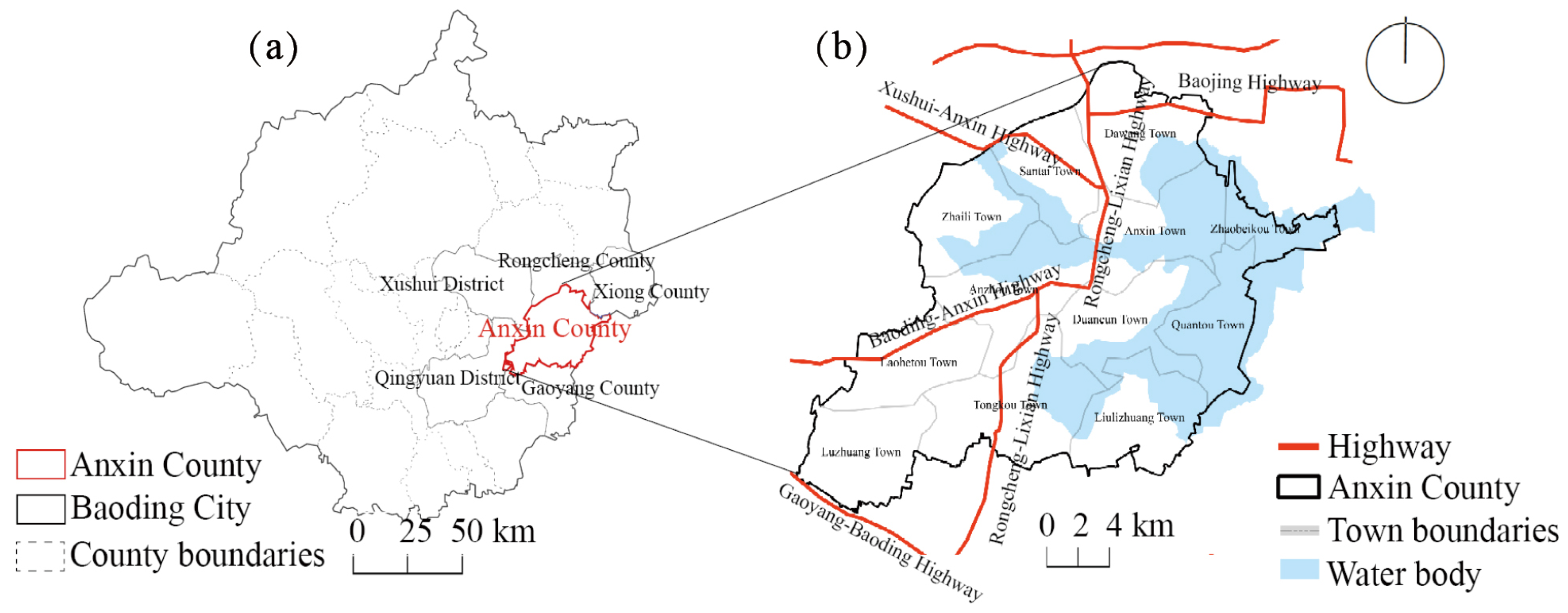

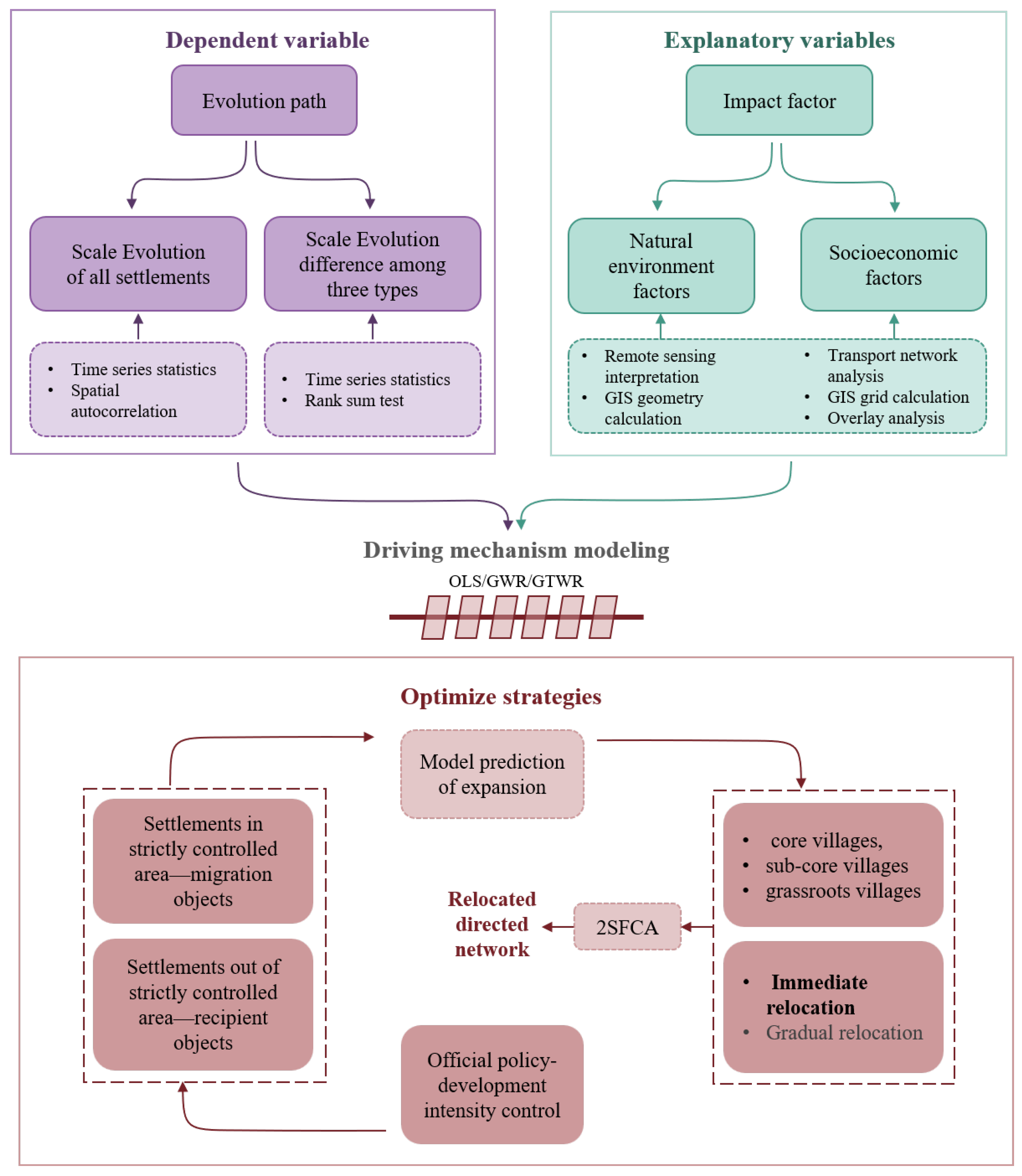
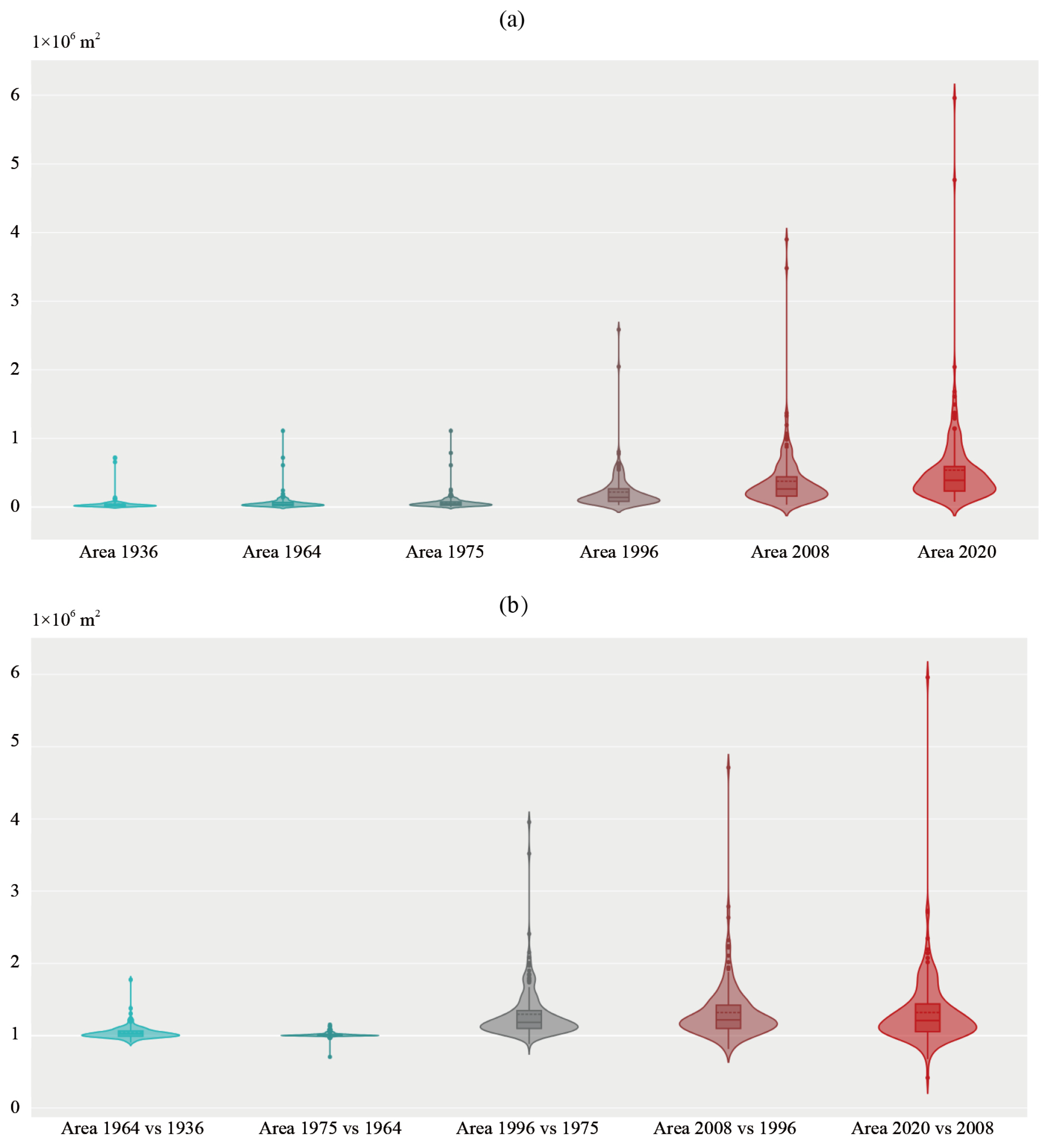
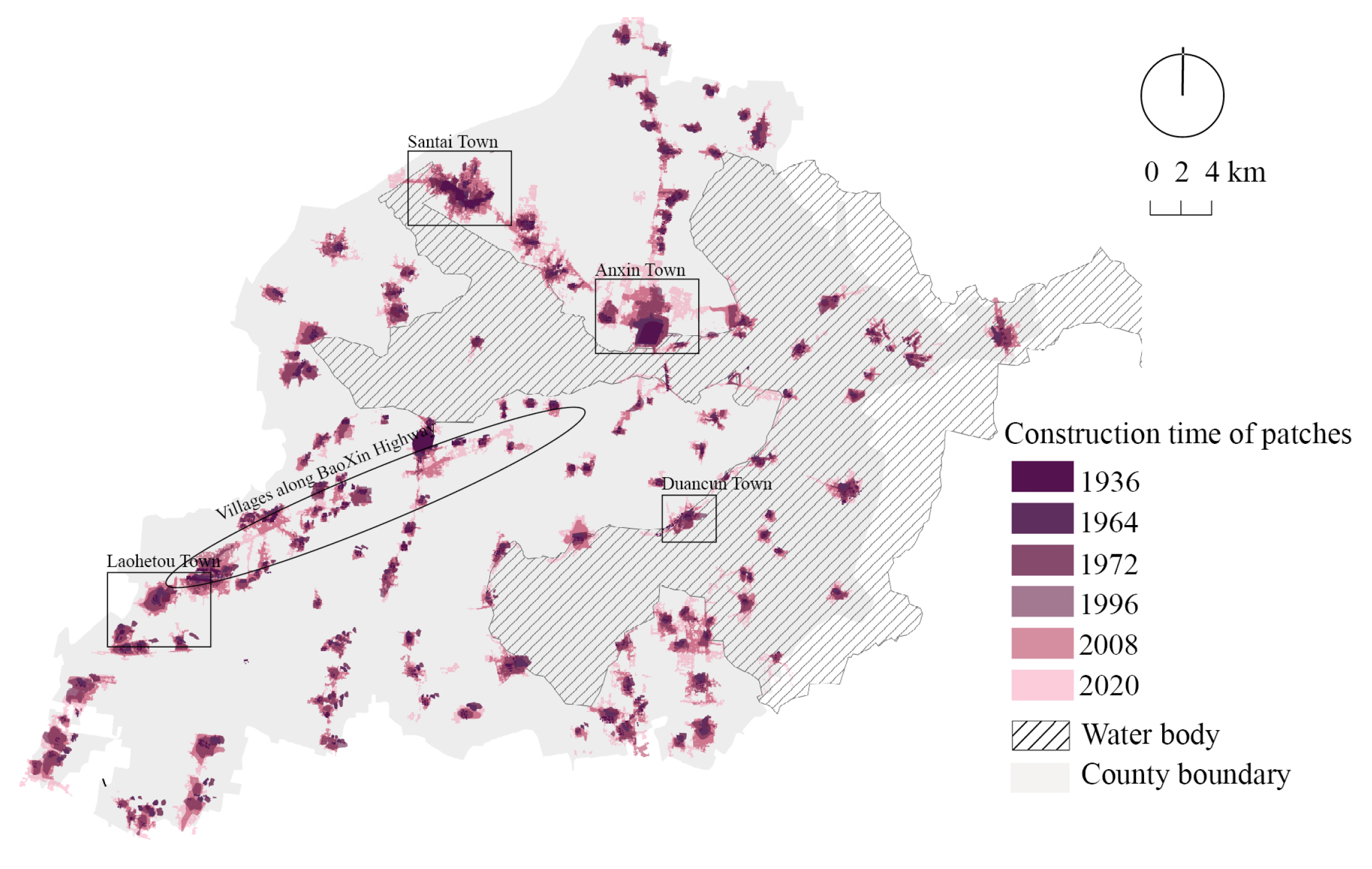
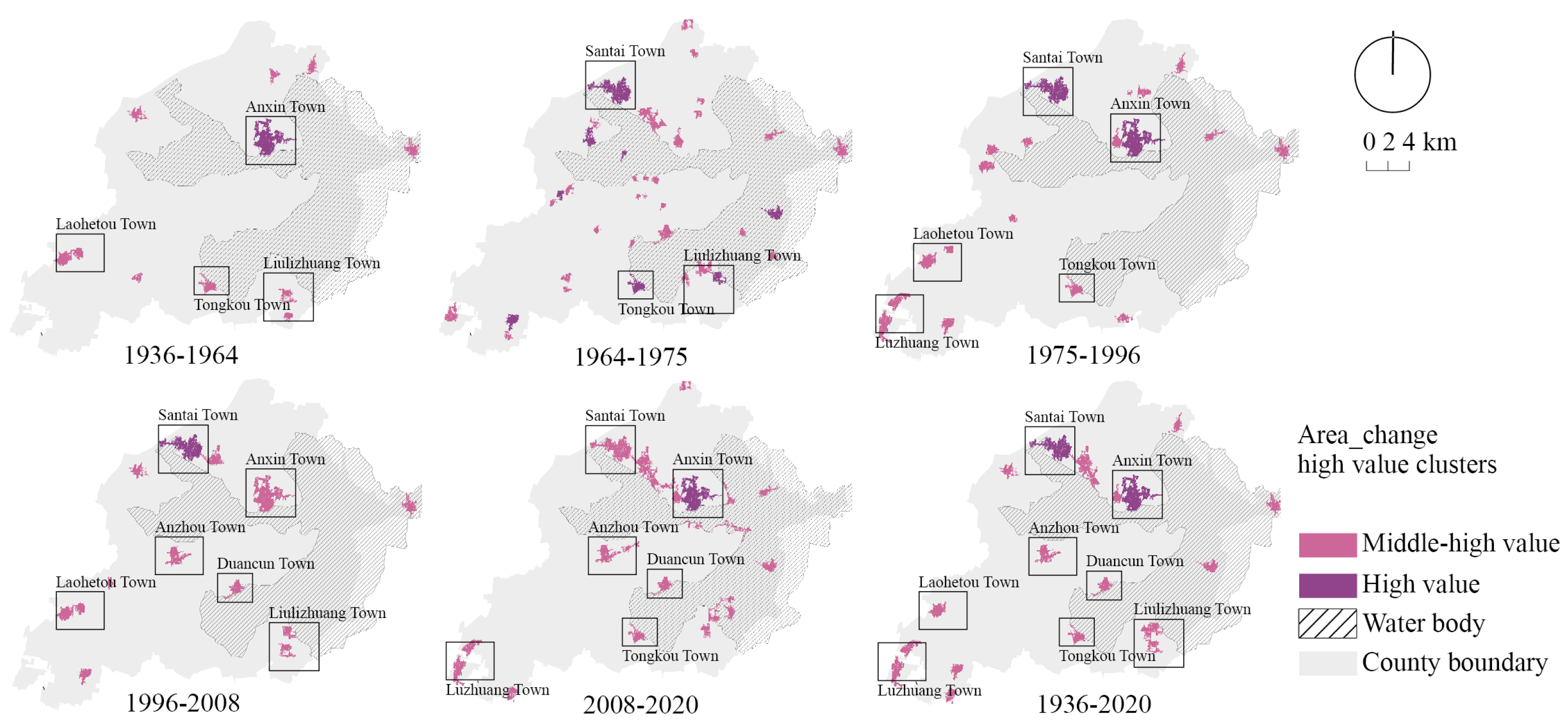

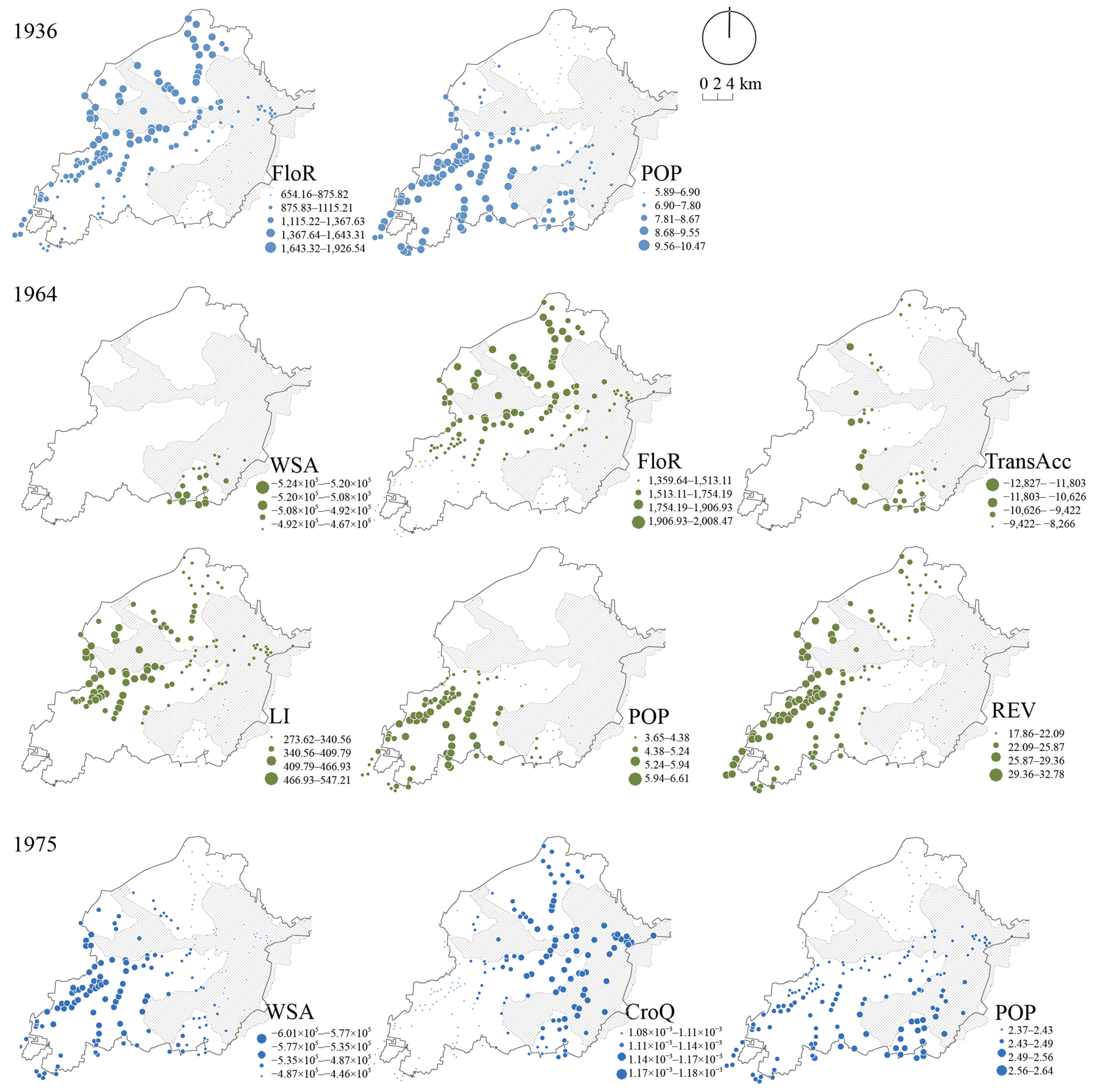


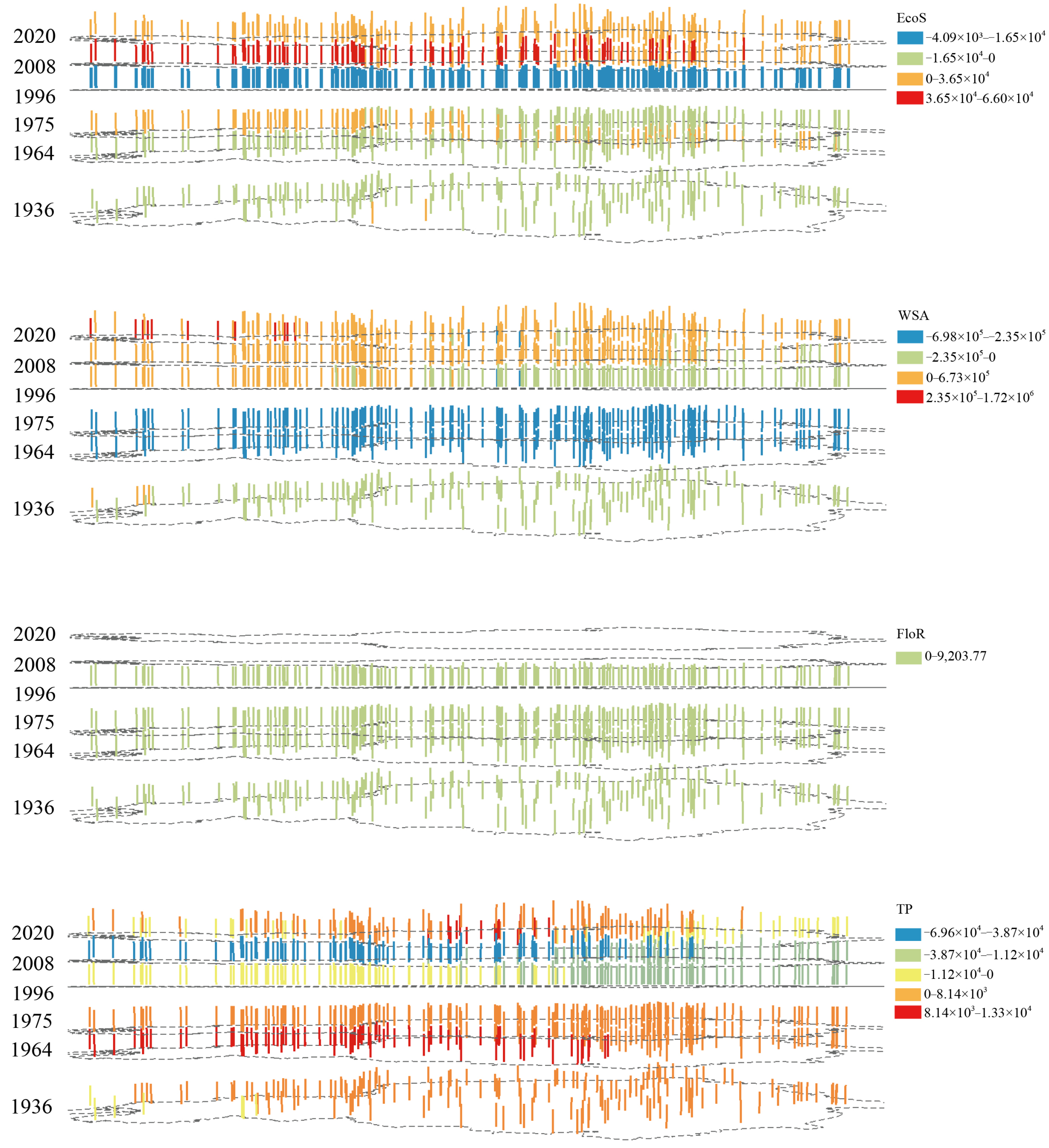
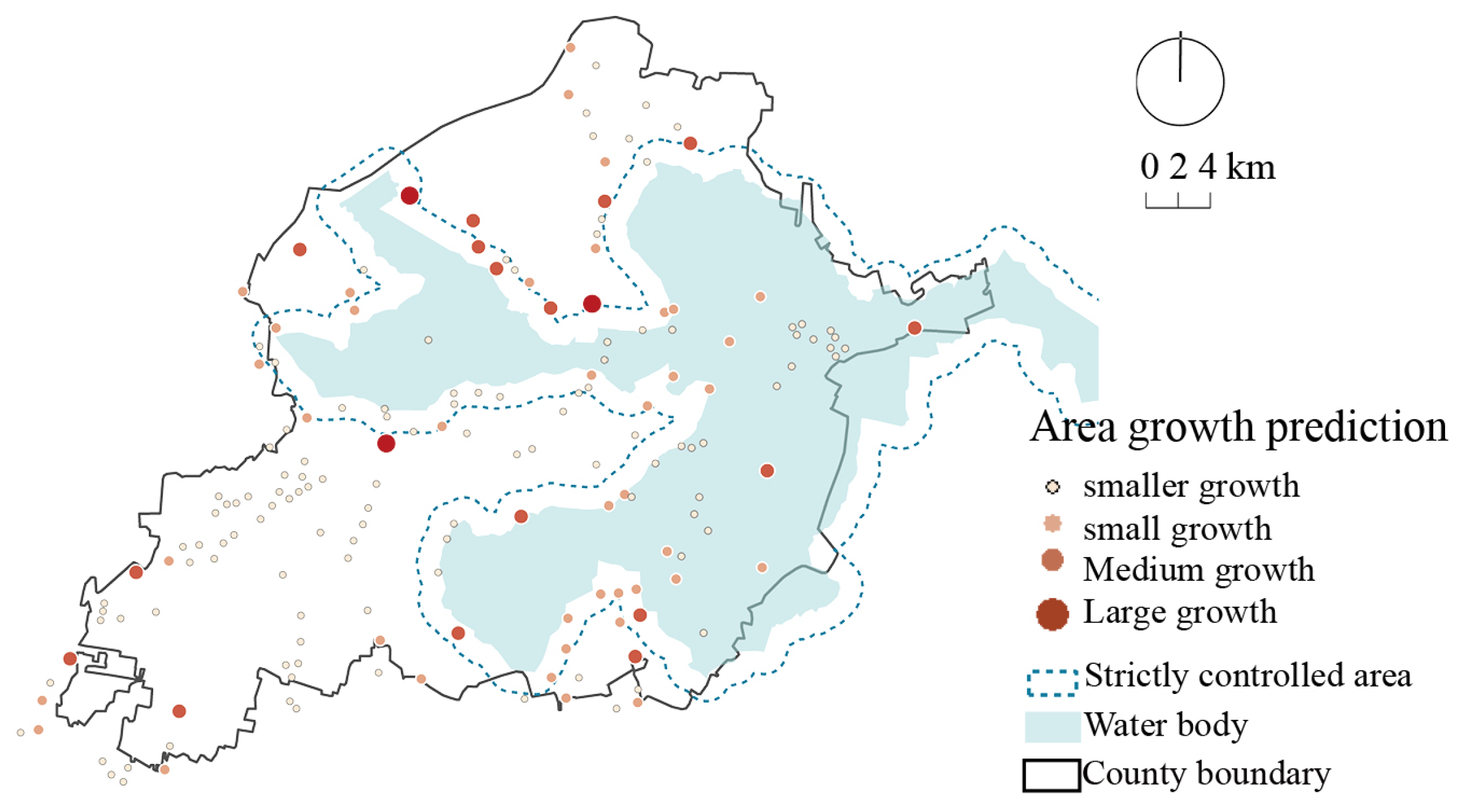
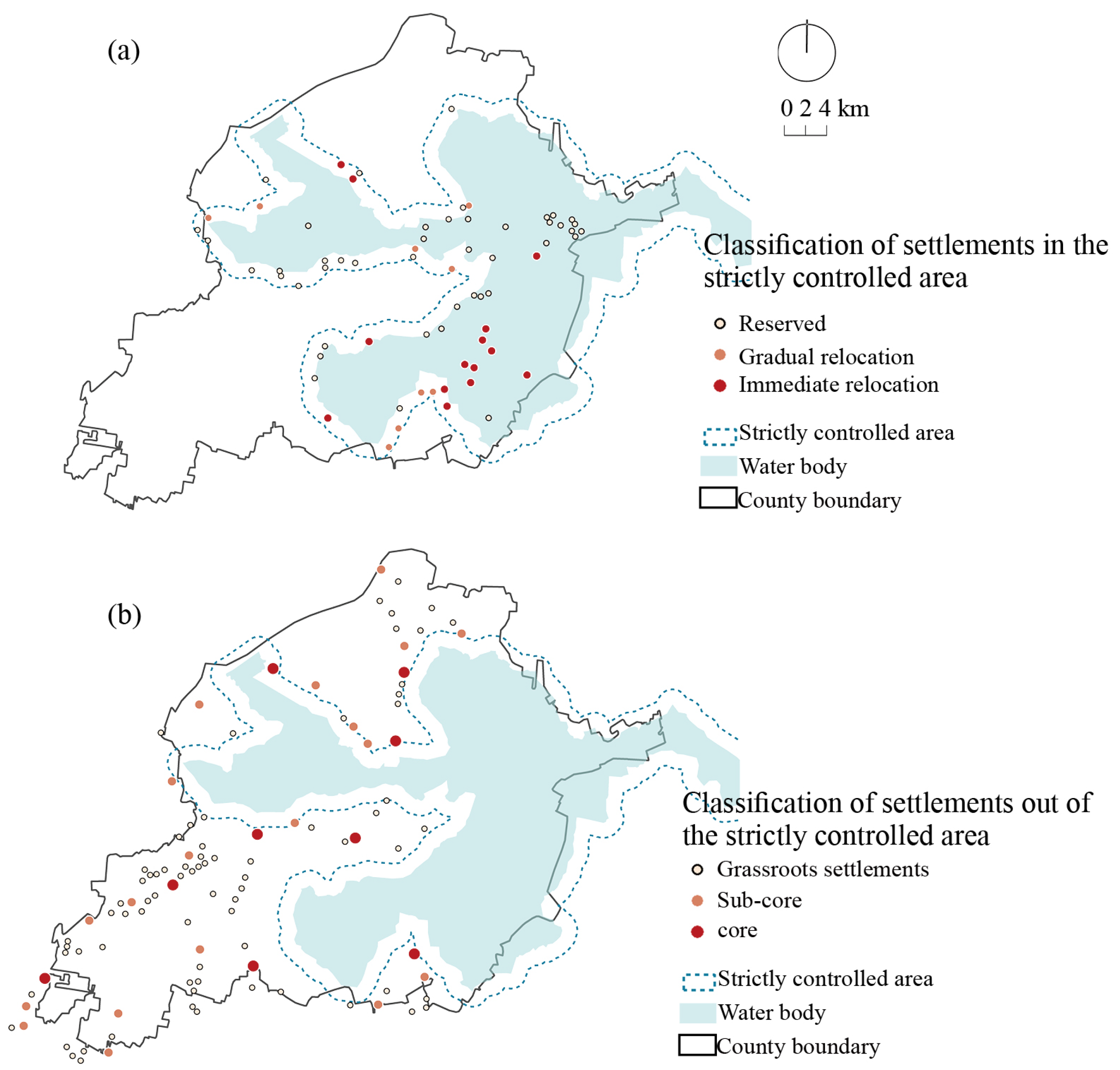
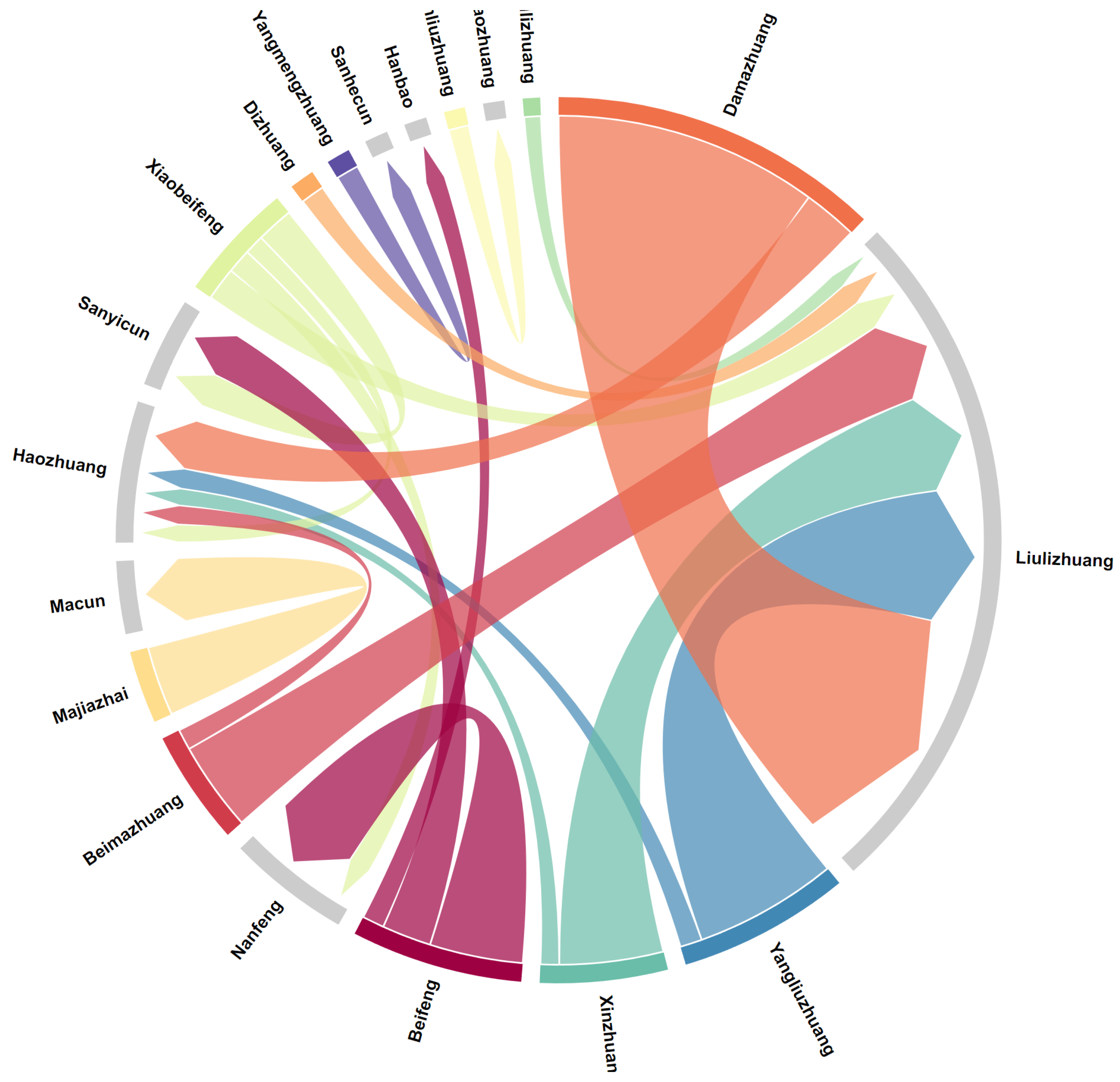
| Types | Abbreviation | Description | Calculation |
|---|---|---|---|
| Natural Factors | EcoS | Ecological sensitivity degree of settlements | The study mainly focuses on the ecological preservation of the Baiyangdian water system. Therefore, all land-based villages were considered to be non-ecologically sensitive villages, with EcoS = 0. Through a reference to official documents on the ecological protection zoning of semi-aquatic and water-based villages, these villages were classified into three levels of sensitivity, i.e., low, medium, and high sensitivity, and they were assigned values of 1, 2, and 3 respectively. |
| WSA | Water resource abundance degree of each settlement | WSA = LEN/S (where LEN is the length of the patch in contact with the water body; S is its area) | |
| FloR | The risk of flooding for settlements | This study extracted four flood records from the county annals for the years 1977, 1978, 1988, and 1996. By comparing remote sensing images between the dry and flood periods, the inundation extents for each flood event were determined. These extents were combined through raster calculations to produce a map depicting flood risk levels. | |
| Socio-economic Factors | TP | The type of settlement, i.e., water settlement, land settlement, or semi-waterside settlement | For water settlements, TP = 0; for semi-waterside settlements, TP = 1; for land settlements, TP = 2 |
| CroQ | The quality of the cultivated land belonging to each settlement | CroQ = / (All settlement center points were used to generate a Voronoi diagram. For each patch i, is the area of its Voronoi diagram. is the planted area of its Voronoi diagram.) | |
| TransAcc | Transportation accessibility of settlements, considering both land and water routes | For water villages, only the accessibility of water transportation was considered. Impedance values were set based on the characteristics of different land uses to construct a cost surface, which was used to classify the transportation accessibility levels for water villages. For land and semi-waterside villages, the primary consideration was accessibility via land transportation. Combining historical records with the road width reflected in satellite images, the road classifications were evaluated and assigned cost values. Using the cost values as weights, the UNA plugin was utilized to calculate the accessibility. Then, the natural breaks method was used to classify the accessibility degree. Finally, the results for land and semi-waterside villages were merged. | |
| LI | Location index, measuring the extent to which the settlement is influenced by its administrative center | (where represents the area of the township-level patch that is nearest to the settlement patch; represents the average area of all township-level patches.) | |
| Socio-economic Factors | BdEx | The built-up extent of a settlement, mainly based on the construction of roads | BuildExtent = L/ (where L represents the length of internal roads in a settlement, represents its area in 2008, and is the year when the internal roads began to be constructed.) |
| Pop | The population of the settlement | Recorded in Anxin County’s local chronicles | |
| REV | Per capita income of the settlement | Recorded in Anxin County’s local chronicles |
| Year | 1936 | 1964 | 1975 | 1996 | 2008 | 2020 |
|---|---|---|---|---|---|---|
| Moran’s I | 0.030 | 0.038 | 0.042 | 0.069 | 0.087 | 0.097 |
| Z-score | 0.938 | 1.167 | 1.264 | 1.874 | 2.296 * | 2.591 * |
| Year | 1964 vs. 1936 | 1975 vs. 1964 | 1996 vs. 1975 | 2008 vs. 1996 | 2020 vs. 2008 |
|---|---|---|---|---|---|
| Moran’s I | 0.146 | 0.065 | 0.091 | 0.124 | 0.120 |
| Z-score | 3.644 * | 1.721 | 2.282 * | 3.129 * | 3.194 * |
| Year | Type | Rank AVE | Ordering |
|---|---|---|---|
| 1964 vs. 1936 | Land | 86.537 | Water < Land < Semi-waterside |
| Semi-waterside | 95.517 | ||
| Water | 78.696 | ||
| 1975 vs. 1964 | Land | 83.455 | Land < Water ≈ Semi-waterside |
| Semi-waterside | 95.828 | ||
| Water | 94.522 | ||
| 1996 vs. 1975 | Land | 89.868 | Water < Semi-waterside < Land |
| Semi-waterside | 84.103 | ||
| Water | 75.565 | ||
| 2008 vs. 1996 | Land | 93.347 | Water < Semi-waterside < Land |
| Semi-waterside | 89.655 | ||
| Water | 50.261 | ||
| 2020 vs. 2008 | Land | 83.008 | Water < Semi-waterside < Land |
| Semi-waterside | 100.414 | ||
| Water | 91.087 |
| Year | OLS | GWR | GTWR | ||||||
|---|---|---|---|---|---|---|---|---|---|
| AIC | Adjusted | RSS | AIC | Adjusted | RSS | AIC | Adjusted | RSS | |
| 1936 | 4145 | 0.323 | 2.22 × 1011 | 4102 | 0.486 | 1.53 × 1011 | 26,742 | 0.722 | 1.15 × 109 |
| 1964 | 4106 | 0.463 | 1.75 × 1011 | 4092 | 0.518 | 1.44 × 1011 | 1.78 × 1011 | ||
| 1975 | 3901 | 0.145 | 0.54 × 1011 | 3903 | 0.207 | 0.53 × 1011 | 0.59 × 1011 | ||
| 1996 | 4506 | 0.681 | 1.75 × 1012 | 4496 | 0.705 | 1.49 × 1012 | 1.79 × 1012 | ||
| 2008 | 4549 | 0.659 | 2.14 × 1012 | 4520 | 0.708 | 1.76 × 1012 | 2.72 × 1012 | ||
| Year | EcoS | WSA | FloR | TP | CroQ | TransAcc | LI | Pop | REV | BdEx |
|---|---|---|---|---|---|---|---|---|---|---|
| 1936–1964 | / | / | + | / | / | / | / | + | / | / |
| 1964–1975 | / | − | + | / | / | − | + | + | + | / |
| 1975–1996 | / | − | − | / | + | / | / | + | / | / |
| 1996–2008 | / | / | + | / | / | − | + | + | + | / |
| 2008–2020 | / | / | / | / | + | / | + | + | + | − |
Disclaimer/Publisher’s Note: The statements, opinions and data contained in all publications are solely those of the individual author(s) and contributor(s) and not of MDPI and/or the editor(s). MDPI and/or the editor(s) disclaim responsibility for any injury to people or property resulting from any ideas, methods, instructions or products referred to in the content. |
© 2024 by the authors. Licensee MDPI, Basel, Switzerland. This article is an open access article distributed under the terms and conditions of the Creative Commons Attribution (CC BY) license (https://creativecommons.org/licenses/by/4.0/).
Share and Cite
Wang, C.; He, J. Long-Term Evolution of Ecologically Fragile Waterside Rural Areas and Strategies for Local Spatial Planning: An Empirical Study in Baiyangdian, China. Land 2024, 13, 1675. https://doi.org/10.3390/land13101675
Wang C, He J. Long-Term Evolution of Ecologically Fragile Waterside Rural Areas and Strategies for Local Spatial Planning: An Empirical Study in Baiyangdian, China. Land. 2024; 13(10):1675. https://doi.org/10.3390/land13101675
Chicago/Turabian StyleWang, Chaoqun, and Jie He. 2024. "Long-Term Evolution of Ecologically Fragile Waterside Rural Areas and Strategies for Local Spatial Planning: An Empirical Study in Baiyangdian, China" Land 13, no. 10: 1675. https://doi.org/10.3390/land13101675
APA StyleWang, C., & He, J. (2024). Long-Term Evolution of Ecologically Fragile Waterside Rural Areas and Strategies for Local Spatial Planning: An Empirical Study in Baiyangdian, China. Land, 13(10), 1675. https://doi.org/10.3390/land13101675







